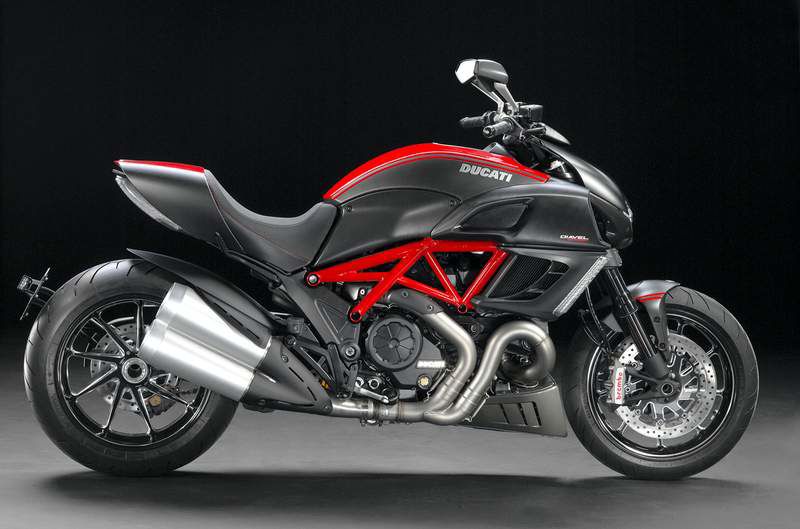Another Ducati bike that defies categorization
Published 5:00 am Friday, July 29, 2011

- The 2011 Ducati Diavel Carbon starts at $19,995 and has the ability to adjust traction control and the ride-by-wire throttle. Or you can use one of three standard settings: urban, touring or sport.
Even for riders steeped in the scope of Ducati’s model range, the first in-person encounter with a 2011 Diavel is likely to raise many questions: Is this a sport bike or a cruiser? Is it built for comfort or for speed?
And why does it look like the progeny of a dragster and Han Solo’s ray gun?
The Diavel is Ducati’s latest addition to a product line that has expanded the company’s offerings far beyond the track-ready sport bikes that built its reputation. Like the play-dirty Hypermotard, introduced in 2008, and the revamped Multistrada, which arrived last year, the Diavel’s mission is to draw a new category of customers into dealerships.
The Diavel, however, is a bigger gamble than the company’s other recent entries: Its startling looks could scare off some potential buyers, its form has few links to the brand’s heritage and it starts at $19,995 for the Diavel Carbon (not including a $365 destination charge for the bike I tested in New York). A more basic Diavel, differing mostly in cosmetics, starts at $16,995.
Spoiler alert: Even after spending some quality time and miles with a Diavel, I was not able to neatly classify the bike’s purpose.
It doesn’t fit some of my criteria for awesomeness. It is neither a sculptured Italian beauty like the 1198 Superbike nor a versatile all-business beast like the Multistrada. Its styling sets off in a direction that few Ducati loyalists would expect from the company, an in-your-face showboat that favors overt brawn over tasteful restraint.
At least it’s powerful
What the Diavel did do superbly was put me at ease, giving me the confidence to make use of its power.
The engine is easy to love. It’s based on the same 1,198cc V-twin that powers the Multistrada 1200 and the 1198 Superbike. In the Diavel (pronounced dee-AH-vull and, sure enough, a name that nods to the devil), it’s tuned to churn out 162 horsepower, with a top torque of 94 pound-feet, according to Ducati.
The riding position is relaxed, but still a bit taxing: The Diavel’s seat is positioned far back, nearly atop the rear wheel. That position, combined with the 30.3-inch seat height and the bike’s 62.6-inch wheelbase, means that the rider’s mass feels more connected to the bike. This rider’s mass felt that way, at least.
At 6-foot-3, and having a body-mass index that marathon champions do not envy, I find it hard to get comfortable in the tucked position that racetrack-replica machines impose. It’s more than just the elephant-on-a-tricycle feeling; motorcycles that are scaled to wiry MotoGP stars like Valentino Rossi often feel a bit out of their element with me in the saddle.
I imagine that the sensation is somewhat like handling a loaded pistol that’s been cocked and then coated in grease: A lot of my energy is directed to just making sure no one gets hurt.
The Diavel, though, put me closer to the machine’s core. Acceleration was astonishing, and the dragbike-inspired riding posture helped me feel fully in control. Taking a sharp corner, I felt more assured than I would on a comparably powerful sport bike — no hanging off required.
Unusual design choices
Long before it reached any showrooms, the Diavel was skewered for its styling. In particular, the 8-inch-wide rear wheel and its 240-millimeter wide tire were criticized as a tic whose benefit was mostly visual, attractive mainly to the custom-bike set.
The critics have a point: The dimensions of the Pirelli Diablo Rosso II tire, developed especially for the Diavel, probably make the bike slower around a racetrack. But for riders on public roads, that tire may just add to the impression of security, letting them lean more and worry less.
Many reviewers have compared the Diavel to so-called power cruisers like Yamaha’s Star-branded VMax and the Harley-Davidson V-Rod. But in pursuing a segment so far outside its traditional sport bike segment, Ducati has, in fact, created something entirely different, innovating in the design, the capabilities and the level of sophistication.
While all of these machines provide powerful engines and mostly upright riding positions, only the Diavel does so while keeping weight under control. The VMax and V-Rod churn out plenty of horsepower, but they each weigh in around 650 pounds; the Diavel Carbon, some 200 pounds lighter, is in another class entirely.
In addition, the bike comes loaded up with Ducati’s suite of digital wizardry. You can adjust the traction control and the ride-by-wire throttle, or just choose one of the three standard operating modes: Urban, which drops engine output to 100 horsepower and sets the highest level of traction control intervention; Touring, which opens up the full 162 horsepower and dials back traction control a hair; and Sport, which limits the chaperone actions of the traction control even more.
Twisting the throttle sharply can make the ride aboard the Diavel a head-banging, white-knuckle experience, yet it is a machine that manages to put a rider like me at ease. It’s a solution to a problem I didn’t know I had.
And that’s part of Ducati’s plan: to introduce a new model that attracts first-time buyers to the brand without stealing sales from its existing stable.
“We weren’t breaking our own mold,” said John Paolo Canton, a Ducati spokesman. “We were breaking everyone else’s mold.”
That may be true; the Diavel was more of a thrill than I expected. No matter that I never did figure out exactly where it fits on the Ducati family tree.






